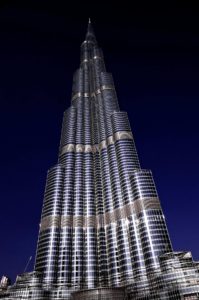Dubai is home to extraordinary history, innovative technology, and flavorful cuisine. It is also home to some amazing architecture, including the tallest building in the world, the Burj Khalifa (Arabic for Khalifa Tower). Reaching a total height of 2,722 feet (and breaking all height records), the tower has instituted a new breed of high rise known as the “mega tall skyscraper.”
The Tower first broke ground in 2004 and it was completed six years later as part of a new development called Downtown Dubai. It was designed to be a mixed-use space addressing the diverse needs of the population and, equally as important, to bring international recognition and increased investment to the region.
Although the Tower was originally named Burj Dubai, its moniker was changed to honor the president of the United Arab Emirates (UAE) and ruler of Abu Dhabi, Sheikh Khalifa bin Zayed Al Nahyan. The UAE and the city of Abu Dhabi both contributed to the building of the Tower by lending money and paying off associated debts.
Designed as an Homage to the Region
 The massive tower was designed by Adrian Smith, whose firm also developed the Sears/Willis Tower in Chicago and the One World Trade Center in Lower Manhattan. The Burj Khalifa is particularly notable because of the way it pays homage to the Islamic architecture of the region, which encompasses a wide range of secular and religious styles throughout history.
The massive tower was designed by Adrian Smith, whose firm also developed the Sears/Willis Tower in Chicago and the One World Trade Center in Lower Manhattan. The Burj Khalifa is particularly notable because of the way it pays homage to the Islamic architecture of the region, which encompasses a wide range of secular and religious styles throughout history.
Fittingly for the various stages of life, the four main principles of Islamic architecture are the Mosque, the Tomb, the Palace, and the Fort – each of which represent an aspect of human life on earth. The Burj Khalifa’s design was based largely on the 9th-century Great Mosque of Samarra, which is located in Iraq. First commissioned in 848 and completed in 851, the Great Mosque of Samarra was, for a long time, the largest mosque in the world.
The Burj Khalifa also includes Persian, Roman, Chinese, Indian, and Byzantine influences of geometric and interlace patterned ornaments. The incredible height of the building is supported by a buttressed central core and wings extended from the foundation.
Attention was not just paid to aesthetics, but to pragmatism as well. Because the city of Dubai can reach up to 115 degrees in the summer, the external walls are covered with a cladding system of textured stainless steel spandrel panels to protect the structure from weather and support its thermal insulation. It is the centerpiece of a larger development including 30,000 homes, nine hotels, over seven acres of parkland, 19 residential towers, the Dubai Mall, and at least 30 acres of artificial lake.
The Tower’s Innovative Infrastructure
In terms of infrastructure, the Burj Khalifa combines the latest technologies with cultural influences to create a global icon that is a model for the future of urban centers and recognition of the need for more compact, city-based areas. Construction practices were re-imagined and re-conceptualized to create a building different from other infrastructure in the region – or the world.
For example, it not only cools itself with state-of-the art air conditioning, but the water from these systems is collected to prevent it from entering the wastewater stream, thereby reducing the demand for municipal potable water. This type of dual-mode thinking is precisely what has propelled this incredible structure into the next century. This management system also utilizes smart lighting and mechanical controls that lower operational costs, allow for a more efficient use of building resources, and better control internal comfort.
While some skyscrapers are first conceived as exteriors that are then internally filled in once completed, the designers of the Burj Khalifa planned the interior space at the earliest possible stages. They focused on three main goals: to honor the sheer height of the building; to integrate its structural and architectural rationale; and to appreciate the heritage, history, and culture of the region. Great pains have been taken to enrich the interior, and an art program placed 500 unique pieces from around the world throughout the Tower. This art was featured at the building’s unveiling.
The Tower as Tourist Destination
As Dubai’s most iconic destination, the Burj Khalifa features an outdoor observatory that soars to 1,821 feet and allows people to envision what it would feel like to soar over the entire city. It is the world’s highest observation deck and is comprised of luxurious and practical lounges for tourists and residents.
Special telescopes provide further enrichment and do much to capture the spectacular views below. Visitors to the Tower can also enjoy an exhibit reliving its historic build and get to know about the people “behind Burj” who made it what it is today. There is even a souvenir shop.

